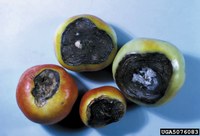Dakota Gardener: Avoid the two most common tomato problems
(Click an image below to view a high-resolution image that can be downloaded)
By Esther E. McGinnis, Horticulturist
NDSU Extension
Do you know what the two most common tomato problems are? Many gardeners assume that diseases or insects cause the most common problems. However, after a dozen years working for North Dakota State University Extension, that has not been my experience. Year after year, the most common tomato problems are herbicide damage and blossom end rot.
Like clockwork, Extension agents receive many emails every July from gardeners displaying the tell-tale symptoms of herbicide damage. Tomatoes are extremely sensitive to herbicides such as 2,4-D and dicamba. When exposed, the leaves become distorted and may curl. The stem and leaf petioles may twist and bend, resulting in an abnormal-looking plant.
Tomatoes may be exposed to herbicides from different sources. The most common source is drift from people’s lawn herbicide applications or from adjacent farms. Other routes include the incorporation of contaminated compost or manure into the garden soil. City compost is primarily composed of grass clippings. Unfortunately, some homeowners spray their lawns with herbicide, collect their lawn clippings, and then contribute them to the municipal compost stream. The composting process does not break down the herbicides. Similarly, manure may be contaminated if the cows eat pasture vegetation that has been sprayed with herbicides. The herbicide doesn’t degrade in a cow’s four-chambered stomach and is excreted in the manure.
One way to greatly reduce herbicide damage to tomatoes would be to limit or eliminate the application of lawn herbicides in the summer. Weeds are less susceptible to herbicides in summer. Mid-fall is a better time to treat perennial lawn weeds to ensure a systemic kill. Secondly, research your compost or manure source and ask the hard herbicide questions.
The second most common tomato problem is blossom end rot. Virtually anyone who has grown tomatoes has watched the fruit's bottom turn brown and rot. This is not a disease but rather a complex condition involving water, nutrients, and genetics. Blossom end rot is a calcium deficiency in the fruit. Calcium is necessary for the building of cell walls in plants. Before adding calcium-based antacids to the soil like some of my relatives do, gardeners need to understand that regional soils are calcium-rich. How to reconcile this apparent contradiction?
Drought is a significant factor. Tomatoes need rain or irrigation to saturate the soil, dissolve the available calcium, and then be absorbed by the root system. The tomato’s vascular system transports the calcium throughout the plant. Here’s another complication—if gardeners are over-fertilizing with ammonium-based nitrogen, potassium or magnesium, that may interfere with calcium uptake and distribution. Finally, cultivating too close to the tomato plants may damage the root system, which also impedes the absorption of water and calcium.
Blossom end rot can be minimized by maintaining evenly moist soils and avoiding over-application of fertilizers. Another factor includes cultivar susceptibility. For example, Roma tomatoes are quite susceptible to this disorder while grape and cherry tomatoes are less susceptible.
For questions on your tomatoes, please contact your friendly NDSU Extension county agent. Find the Extension office for your county at ndsu.ag/countyoffice.
NDSU Agriculture Communication – July 2, 2025
Source: Esther McGinnis, 701-231-7406, esther.mcginnis@ndsu.edu
Editor: Kelli Anderson, 701-231-6136, kelli.c.anderson@ndsu.edu




